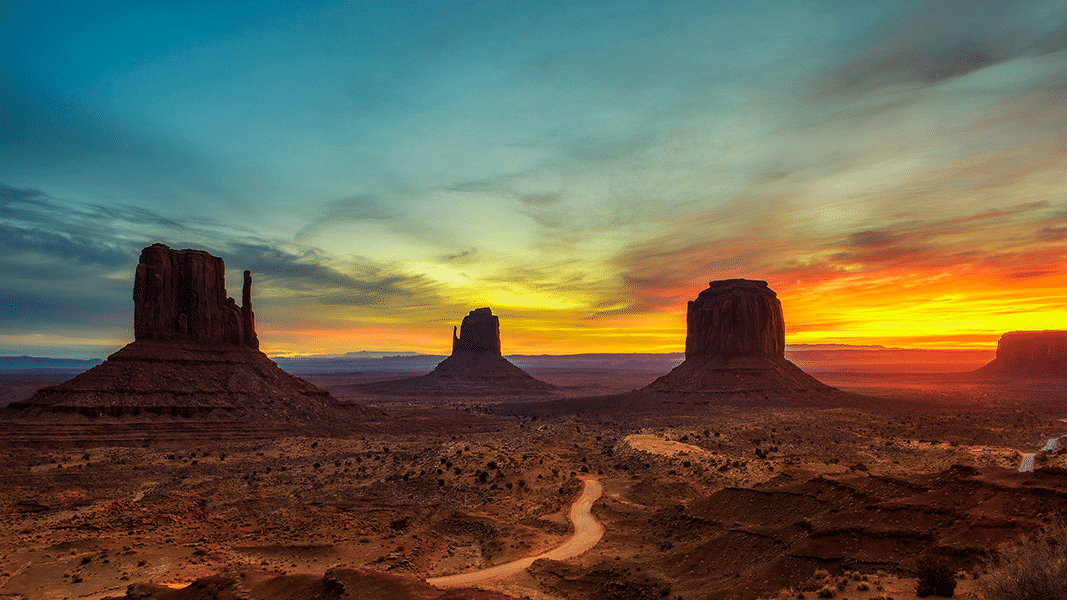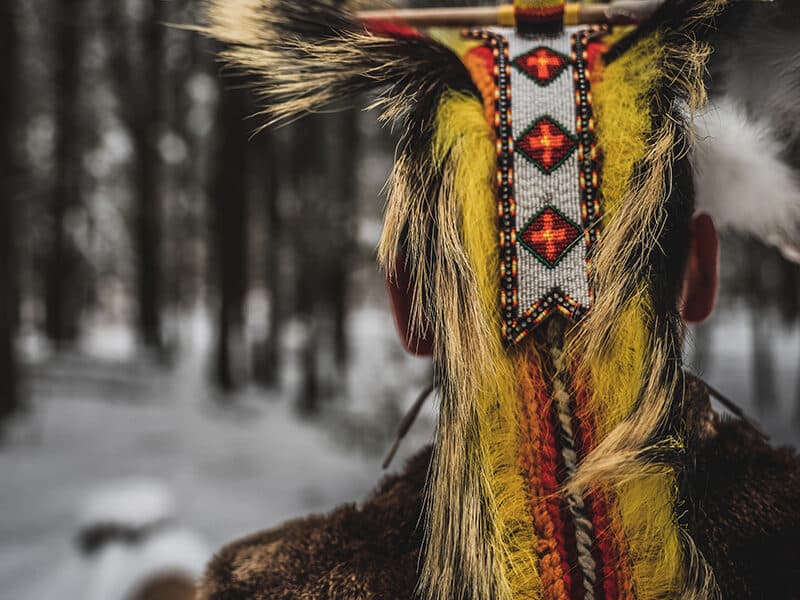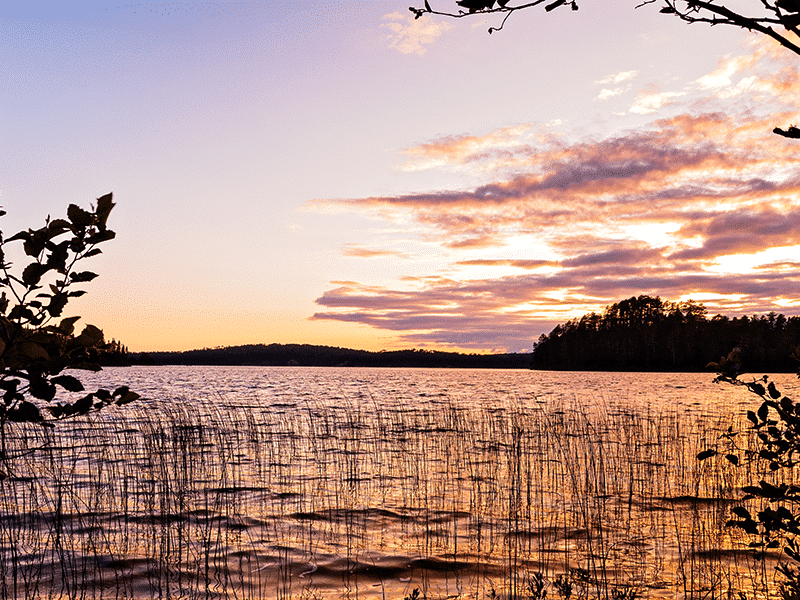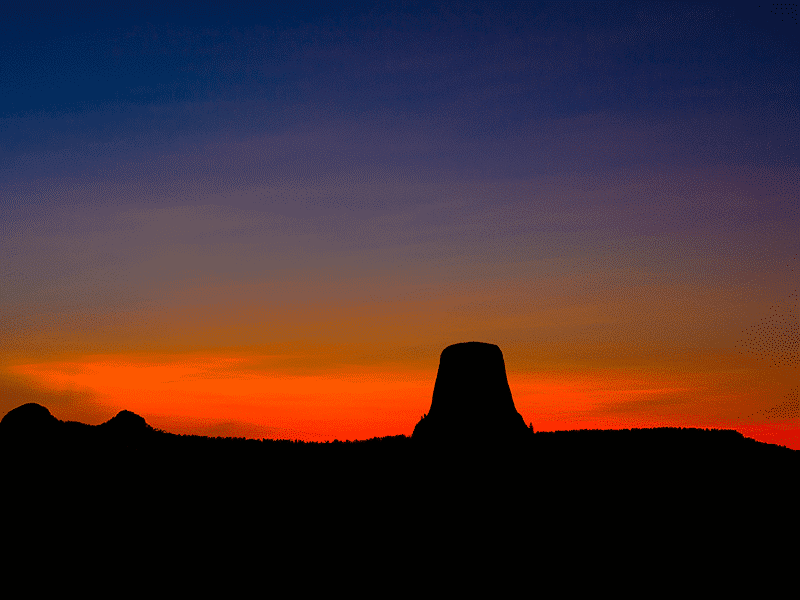Four Corners — where Arizona, New Mexico, Utah and Colorado meet — is the heart of the Navajo homeland, guarded by four sacred mountains. The high desert territory of the Navajo (who call themselves the Diné in their own tongue) is among the most remote places in the Lower 48 states.
Navajo land stretched across the Colorado Plateau to the Rio Grande before they were pushed west into the desert by Spanish, Mexican, and Yankee settlement. In 1864, Gen. James H. Carleton, convinced that Navajo territory was rich in gold, dispatched Kit Carson to move the Indians out or kill them. In the “Long Walk,” 10,000 Navajo were marched 400 miles to disease and hunger on meager lands at Fort Sumner, NM. In 1868, Gen. William T. Sherman and 29 Navajo headmen signed a treaty allowing the tribe to return to a new reservation on a reduced but still expansive portion of their traditional lands. The reservation remains the largest in the United States by far, although it is an arid domain where red sandstone predominates.
It proved not to be gold, but other minerals under the Navajo earth that would shape their future. It’s a perverse irony that this homeland, circumscribed by the sacred mountains San Francisco, Hesperus, Blanca and Taylor, is today ringed by four massive coal-burning power plants. These plants since the 1960s have literally fueled the real-estate boom that has transformed the Southwest, fed with coal taken from the reservation’s Black Mesa under contract with the Navajo Nation tribal government. And they often fill the once-pristine desert sky with a smoky haze.
Before that, uranium was mined on reservation lands — resulting in a wave of cancer among Navajo miners and mesa dwellers, and a grim legacy of “uranium widows.”
There are few paved roads on Black Mesa, covering much of the Arizona portion of the reservation, and often no running water. Scare water services this year contributed to a deadly spike of COVID-19 cases on the reservation. This is the Navajo world the tourists don’t seen — a world of ancient traditions, hardscrabble living, goat-herding, and massive mineral exploitation.
Mired in Controversy
Unfortunately, plans to develop a hemp economy as a viable alternative on the reservation have thus far been mired in controversy. On reservation lands in New Mexico, east of Black Mesa in the valley of the San Juan River, an internecine Navajo showdown has been brewing.
On the irrigated farmlands of this tributary of the Colorado River, Navajo tribal police were threatening to raid a multi-greenhouse hemp operation that was seemingly established on nobody’s authority.
In September, the Navajo Nation government went to the tribal district court at Shiprock, NM, and won a preliminary injunction against Dineh Benally, president of the San Juan River Farm Board, and his two companies, Navajo Gold and Native American Agricultural.
In addition to claiming that some of Benally’s crop was actually marijuana, tribal authorities also said investigators from the Navajo Environmental Protection Agency (NEPA) found water-quality violations in his operation, which actually incorporates several local farms. The local Navajo Times reported claims that the operation was improperly using irrigation water, depriving neighboring farms.
An account in Searchlight New Mexico described hired guards in flak jackets patrolling the public roads alongside the complex of greenhouses, ringed with security cameras. It’s also asserted that many of the 1,000 or so employees at the facility are not Navajo but Chinese immigrants brought in from Los Angeles — some underage.
In a new suit brought the following month, the tribal government sought to shut down some 30 other farmers on the reservation on similar grounds, mostly in the San Juan Valley.
Raids by tribal police or even federal agents on these properties appeared to be imminent. NEPA director Oliver Whaley told the Navajo Times his crew were in the middle of an inspection at one of the farms in September when they were chased off by guards and employees. Whaley’s testimony was critical in winning the injunction, as well as a compliance order.
“The compliance order is to allow us to finish our environmental inspections and requiring that Mr. Benally and all farm workers be present to answer questions and provide information,” said Whaley. “If Mr. Benally doesn’t comply with either order, we would continue to move forward with the process of getting Navajo Nation search warrants, as well as working with our federal partners at USEPA to do the same under federal authority. Which processes we have already begun.”
Whose Jurisdiction?
Benally asserts that the Navajo Nation has no jurisdiction over what farmers can grow on their land.
“This current administration is telling the people that these farms belong to Navajo Nation,” he told the Navajo Times. “That is not true and that is what will go before the court … As your farm board president, as your government tribal official, I believe these farms belong to the individual Navajo. It does not belong to the Navajo president. These lands belong to the individual farmers, they don’t belong to the chapter, it doesn’t belong to Window Rock.”
Window Rock is the Navajo Nation capital, across the state line in Arizona, and “chapters” are its administrative divisions. The jurisdictional ambiguity arises from the fact that San Juan Farm Board holdings are private enterprises on leased tribal lands of the San Juan Chapter, receiving water from the US Bureau of Reclamation as part of the Navajo Indian Irrigation Project. The local press accounts portray Benally exploiting his position as Farm Board head to establish a small empire in illegal cannabis.
Benally, on his own website (recently expired, but still archived), says he’s using his leadership position to “collaborate with government delegates, grazing officials, and chapter officials to protect native water rights and improve the economy and livelihood of the Navajo People.” He failed to respond to numerous efforts by Project CBD to reach him.
In any case, Benally’s authority to grow hemp seems dubious. The USDA has not approved Navajo hemp regulation plans. The Navajo Nation’s cannabis law has since 2000 included a carve-out for low-THC hemp, but growing on the reservation is not considered legal by the tribal government until a USDA plan is approved.
Benally has sought approval for a separate plan exclusively for the San Juan River Farm Board, but the USDA rejected it, stating that the body lacked jurisdiction.
The first of the threatened federal raids arrived Nov. 9, when a joint force of FBI agents, New Mexico state police, and Navajo tribal police carried out search warrants on properties near Shiprock. Authorities initially told the press the warrants were sealed and they could not provide details on the investigation. But the US Justice Department later issued a statement claiming that 260,000 “marijuana” plants had been eradicated, and 60,000 pounds seized as evidence — although of what exactly was not stated. The Navajo Times reported that the raids had been dubbed “Operation Navajo Gold” — unsubtly named for one of Dineh Benally’s companies.
The Sacred Earth of Chimayó
Some 100 miles east of the Navajo reservation is the historic village of Chimayó, NM, across the Rio Grande in the foothills of the Sangre de Cristo Mountains. This is just beyond what was once the eastern extent of Navajo territory. This northern section of the Rio Grande Valley is a domain of Pueblo Indians and Chicanos, as well as some white farmers and back-to-the-land hippie types.
Chimayó is a Spanish rendering of the town’s Tewa Pueblo name, Tsi-Mayoh, or Good Obsidian. The Sanctuary of Chimayó, the village’s Catholic shrine that dates to Spanish colonial times, is a point of pilgrimage from across the Southwest. Thought to have curative powers, the very earth of the village is ritually consumed (in minute quantities) by pilgrims.
Earl Tulley grew up on the Navajo reservation, and for many years worked in housing for the tribal government. Today he is a partner in Chimayó Hemp Enterprises, which is producing CBD products from hemp grown in the purportedly miraculous earth of the unincorporated village in Rio Arriba County, north of Santa Fe.
The associated CHE Farms, which last year switched from pear and apple orchards to hemp, is providing CBD-rich cannabis bud for the new enterprise. “Last year, it produced 300,000 grams of flower from 1,200 plants on less than an acre,” Tulley tells Project CBD. “We made gummy bears, oils, and pre-rolled smokables. This year we’re shooting for a million grams from three acres.”
He calls this impressive yield on the outdoor grow “beginners luck” – “We had no early frost.”
Tulley also emphasizes the support for the local indigenous residents for the project: “Pueblo leaders do blessings on our lands. We’re letting them know and respecting them.”
Tulley says he bought into the land 30 years ago, already with eye toward growing hemp. The plot is watered by an acequia, one of Chimayó’s traditional community-owned irrigation channels that date to Spanish times.
Navajo CBD
When Project CBD spoke with Tulley in the first days of November, harvest had just begun after approval of the crop’s THC levels by the New Mexico Department of Agriculture. The state’s Democratic Gov. Michelle Lujan Grisham signed a hemp legalization bill in April 2019.
Tulley is one of three major co-owners of Chimayó Hemp Enterprises, with Teresa Juárez, a Chicana farmer, and Daniel Shreck, an Anglo. “We’re actually doing the Green New Deal,” Shreck said in a YouTube video promoting the project, pointing to its reliance on community resources and indigenous technology.
The enterprise has no storefront as of now, but is selling its products — including CBD dog biscuits — at farmers’ markets and flea markets on what Tulley calls a “flash mob” basis. In light of COVID-19, they are hoping to expand internet sales.
The company won “Best CBD Flower” and “Best Pre-roll” in this year’s Essie Awards, held in Albuquerque in February. The Essie Awards are New Mexico’s equivalent of California’s Emerald Cup, with all dispensaries in the state represented. It’s named in honor of Essie DeBonet, New Mexico’s first enrolled medical cannabis patient.
“CHE was the smallest company,” says Tulley. “And we beat out many multimillion-dollar companies for two of the three awards in the hemp category.”
The enterprise also employs local youth, on a coop basis — they earn a portion of the harvest to independently market as well as their wages. Six are employed year-round, with additional seasonal hires for trimming and packaging.
Good Medicine for the Economy
Tulley emphasizes the pressing need for development on the reservation — now especially critical in light of COVID-19. “There are still families with no running water or indoor plumbing,” he says. “There are six clinics or hospitals for 28,000 square miles, and everyone for a 50-mile radius is gonna be going to that one nearest clinic.”
He believes a hemp economy could be socially salubrious for the reservation. “We had 56% unemployment on the Navajo reservation even before COVID. A lot of people live on a barter economy — corn or squash or melons for firewood. If farmers can get better return on hemp than corn, they can better provide for their families,” he explains.
Tulley hopes to see legal cannabis products become more available on the Navajo reservation, where he perceives a need for their analgesic and soothing properties. “We still have a lot of people with cancer from the uranium mines, and vets dealing with PTSD,” he says.
But Tulley acknowledges that there’s an ingrained cultural-conservative current among the Navajo, who’ve been exposed to relentless reefer madness propaganda. This is an obstacle, which he hopes to overcome. “Domestic violence and criminal activity are the devil,” he says, “not cannabis — contrary to what the evangelicals tell us. Cannabis is medicine.”
In addition to CBD products, he notes that hemp stalk can be used in adobe instead of straw to build traditional dwellings. And that resonates with a lot of people.
As a parting shot, Tulley cites Article 7 of the 1868 Navajo Treaty, with provisions for encouraging settled agriculture on the reservation: “It just tells us to put seeds in the ground. It doesn’t tell us what we couldn’t grow.”
See other articles in the Hemp & Native American Sovereignty series.
Bill Weinberg, a Project CBD contributing writer, is a 30-year veteran journalist in the fields of drug policy, ecology and indigenous peoples. He is a former news editor at High Times magazine and produces the websites CounterVortex.org and Global Ganja Report. © Copyright, Project CBD. May not be reprinted without permission.
Recommended Readings
Reviving Hemp in Menominee Country
Part 1 of a 5-part series on hemp and Native American sovereignty.
Growing a Cannabis Economy on White Earth
Part 2 of a 5-part series on hemp and Native American sovereignty.
Standing Up in Lakota Country
Part 3 of a 5-part series on hemp and Native American sovereignty.
Closing the Circle
The final installment of a 5-part series on hemp and Native American sovereignty.





